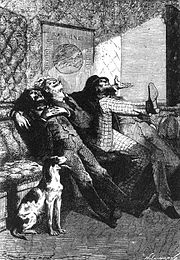
Twenty Thousand Leagues Under the Seas is a classic science fiction adventure novel by French writer Jules Verne.

A trajectory or flight path is the path that an object with mass in motion follows through space as a function of time. In classical mechanics, a trajectory is defined by Hamiltonian mechanics via canonical coordinates; hence, a complete trajectory is defined by position and momentum, simultaneously.

From the Earth to the Moon: A Direct Route in 97 Hours, 20 Minutes is an 1865 novel by Jules Verne. It tells the story of the Baltimore Gun Club, a post-American Civil War society of weapons enthusiasts, and their attempts to build an enormous Columbiad space gun and launch three people—the Gun Club's president, his Philadelphian armor-making rival, and a French poet—in a projectile with the goal of a Moon landing. Five years later, Verne wrote a sequel called Around the Moon.

A Trip to the Moon is a 1902 French adventure short film directed by Georges Méliès. Inspired by a wide variety of sources, including Jules Verne's 1865 novel From the Earth to the Moon and its 1870 sequel Around the Moon, the film follows a group of astronomers who travel to the Moon in a cannon-propelled capsule, explore the Moon's surface, escape from an underground group of Selenites, and return to Earth with a captive Selenite. Méliès leads an ensemble cast of French theatrical performers as the main character Professor Barbenfouillis, in the overtly theatrical style for which he became famous.
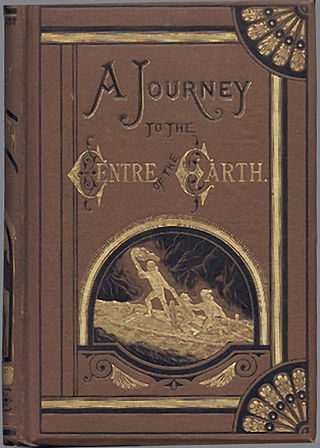
Journey to the Center of the Earth, also translated with the variant titles A Journey to the Centre of the Earth and A Journey into the Interior of the Earth, is a classic science fiction novel by Jules Verne. It was first published in French in 1864, then reissued in 1867 in a revised and expanded edition. Professor Otto Lidenbrock is the tale's central figure, an eccentric German scientist who believes there are volcanic tubes that reach to the very center of the earth. He, his nephew Axel, and their Icelandic guide Hans rappel into Iceland's celebrated inactive volcano Snæfellsjökull, then contend with many dangers, including cave-ins, subpolar tornadoes, an underground ocean, and living prehistoric creatures from the Mesozoic and Cenozoic eras. Eventually the three explorers are spewed back to the surface by an active volcano, Stromboli, located in southern Italy.
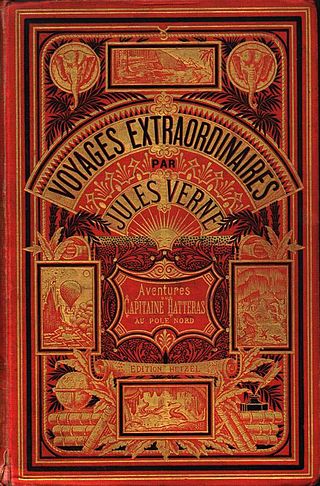
The Voyages extraordinaires is a collection or sequence of novels and short stories by the French writer Jules Verne.

In celestial mechanics, a horseshoe orbit is a type of co-orbital motion of a small orbiting body relative to a larger orbiting body. The osculating (instantaneous) orbital period of the smaller body remains very near that of the larger body, and if its orbit is a little more eccentric than that of the larger body, during every period it appears to trace an ellipse around a point on the larger object's orbit. However, the loop is not closed but drifts forward or backward so that the point it circles will appear to move smoothly along the larger body's orbit over a long period of time. When the object approaches the larger body closely at either end of its trajectory, its apparent direction changes. Over an entire cycle the center traces the outline of a horseshoe, with the larger body between the 'horns'.

A space gun, sometimes called a Verne gun because of its appearance in From the Earth to the Moon by Jules Verne, is a method of launching an object into space using a large gun- or cannon-like structure. Space guns could thus potentially provide a method of non-rocket spacelaunch. It has been conjectured that space guns could place satellites into Earth's orbit, and could also launch spacecraft beyond Earth's gravitational pull and into other parts of the Solar System by exceeding Earth's escape velocity of about 11.20 km/s. However, these speeds are too far into the hypersonic range for most practical propulsion systems and also would cause most objects to burn up due to aerodynamic heating or be torn apart by aerodynamic drag. Therefore, a more likely future use of space guns would be to launch objects into Low Earth orbit, at which point attached rockets could be fired or the objects could be "collected" by maneuverable orbiting satellites.

Voyage: Inspired by Jules Verne is a point-and-click adventure game with pre-rendered graphics, developed by Kheops Studio and published by The Adventure Company for the PC in 2005. The game's story focuses on a French adventurer's journey to the Moon in the 19th century, and the ancient lunar civilization he subsequently finds.

The First Men in the Moon is a scientific romance by the English author H. G. Wells, originally serialised in The Strand Magazine from December 1900 to August 1901 and published in hardcover in 1901, who called it one of his "fantastic stories". The novel tells the story of a journey to the Moon undertaken by the two protagonists: a businessman narrator, Mr. Bedford; and an eccentric scientist, Mr. Cavor. Bedford and Cavor discover that the Moon is inhabited by a sophisticated extraterrestrial civilisation of insect-like creatures they call "Selenites". The inspiration seems to come from the famous 1870 book by Jules Verne, From the Earth to the Moon, and the opera by Jacques Offenbach from 1875. In that opera the word "selenites" is used for the first time for moon inhabitants.

The columbiad was a large-caliber, smoothbore, muzzle-loading cannon able to fire heavy projectiles at both high and low trajectories. This feature enabled the columbiad to fire solid shot or shell to long ranges, making it an excellent seacoast defense weapon for its day. Invented by Colonel George Bomford, United States Army, in 1811, columbiads were used in United States seacoast defense from the War of 1812 until the early years of the 20th century. Very few columbiads were used outside of the U.S. and Confederate Armies; nevertheless, the columbiad is considered by some as the inspiration for the later shell-only cannons developed by Frenchman Henri-Joseph Paixhans some 30 years later.
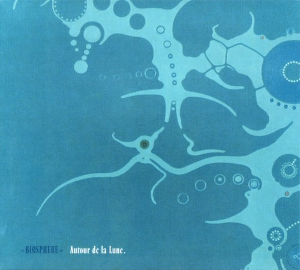
Autour de la Lune is an album by ambient musician Biosphere which was released on 17 May 2004. The album presents a striking difference from others in the Biosphere catalog due to its percussionless, minimalistic soundscapes consisting mostly of white noise and the sounds of the Mir space station, related to drone music. It featured cover art by the Norwegian contemporary artist Tor-Magnus Lundeby.

Claims of the existence of other moons of Earth—that is, of one or more natural satellites with relatively stable orbits of Earth, other than the Moon—have existed for some time. Several candidates have been proposed, but none have been confirmed. Since the 19th century, scientists have made genuine searches for more moons, but the possibility has also been the subject of a number of dubious non-scientific speculations as well as a number of likely hoaxes.
In astronomy, a co-orbital configuration is a configuration of two or more astronomical objects orbiting at the same, or very similar, distance from their primary, i.e. they are in a 1:1 mean-motion resonance..
Reverend Lewis Page Mercier is known today as the translator, along with Eleanor Elizabeth King, of three of the best-known novels of Jules Verne: Twenty Thousand Leagues under the Seas, From the Earth to the Moon, and Around the Moon. To avoid a conflict of interest with his position as chaplain, Mercier wrote under the pen names of Louis Mercier, MA (Oxon) and Mercier Lewis.

Star Wars: Hyperspace Mountain is an indoor/outdoor steel roller coaster in Discoveryland at Disneyland Paris. Originally themed around Jules Verne's classic 1865 novel From the Earth to the Moon, the attraction first opened on June 1, 1995, three years after the park's debut in an attempt to draw more guests to the financially unstable European resort. Unlike other Space Mountain attractions at Disney theme parks, the installation at Disneyland Paris had a steampunk-detailed appearance with a Columbiad Cannon and a plate-and-rivet exterior under its previous theme. It is the only Space Mountain to feature inversions, a launch, a section of track that exits and re-enters the interior, and a synchronized on-Board audio track. It is by far the largest Space Mountain installation at any Disney theme park.
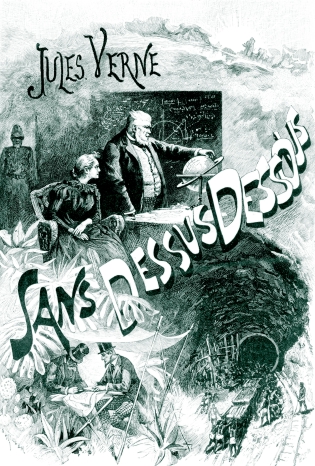
The Purchase of the North Pole or Topsy-Turvy is an adventure novel by Jules Verne, published in 1889. It is the third and last novel of the Baltimore Gun Club, first appearing in From the Earth to the Moon, and later in Around the Moon, featuring the same characters but set twenty years later.
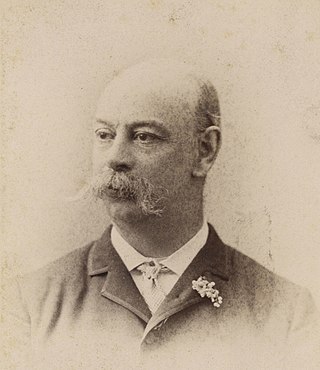
George Makepeace Towle was an American lawyer, politician, and author. He is best known for his translations of Jules Verne's works, in particular his 1873 translation of Around the World in Eighty Days.

The life and works of the French filmmaker Georges Méliès (1861–1938), including his famous short film A Trip to the Moon, have been referenced many times in creative works, including the following examples.

Command module Columbia (CM-107) is the spacecraft that served as the command module during Apollo 11, which was the first mission to land humans on the Moon. Columbia is the only spacecraft of the 1969 Apollo 11 mission that returned to Earth.

